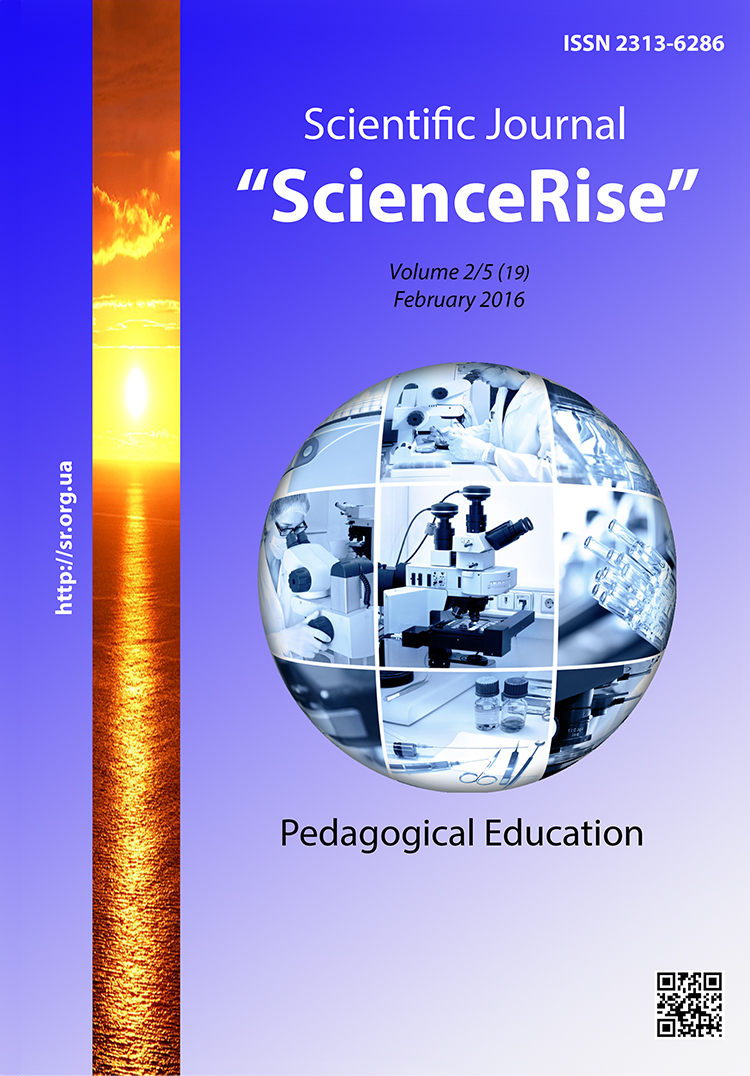Підготовка майбутніх педагогів до естетизації освітнього середовища початкової школи
DOI:
https://doi.org/10.15587/2313-8416.2016.60509Ключові слова:
естетотерапія, творчий розвиток особистості, психологічно-комфортне середовище, професійна підготовка вчителя, функції естетотерапіїАнотація
У статті висвітлюються питання підготовки майбутніх учителів початкової школи до використання естетотерапевтичних технологій розвитку особистості, надання творчого характеру навчально-виховному процесу та створення психологічно комфортного освітнього середовища. Особлива увага приділена таким змістовим аспектам професійної освіти педагога: аналіз сучасного стану освітнього середовища, педагогічний потенціал естетичного та психолого-педагогічні функції естетотерапії
Посилання
Slastenin, V. A., Podumova, L. S., (1997). Pedagogy: Innovational activities. Moscow: MastersPublisher, 224, 73–79.
Alekseenko, T. F., Onychenko, V. M., Ball, G. O. et. al; Kremen, V. G. (Ed.) (2010). White Book of National Education of Ukraine. Kyiv: Informationalsystems, 342, 56.
Kagan, M. S.(2007). System-synergetic approach towardsconstruction of the Modernpedagogic theory. Synerhetycheskaya paradigm. Synergetics education. Moscow: Progress-Tradition, 212–245.
Ridings, B. (2010). University in ruins. Moscow: Publishing house, 304.
Robinson, K. (2013). Education against talent. Moscow: Mann, Ivanov and Ferber, Eksmo, 336.
Chumak, O. V. (2012). Paradigm Education XXI century: innovative aspects. Personality in a single educational space. Available at: http://virtkafedra.ucoz.ua/el_gurnal/pages/vyp7/konf1/Chumak.pdf
Kremen, V. G. (2009). Personality in the modern civilization: the educational context. Universitates: Science and Education, 1, 28–32.
Drescher, U. N., Klyuchenko, T. I. (2002). Bilbo-therapeutic activities of the libraries in the context of information and psychotherapeutic security. Kazan. Available at: http://www.gpntb.ru/win/inter-events/crimea2002/trud/sec1114/doc77.HTML
Hёbel, V., Glöckler, M.; Fedorov, N. (Ed.) (1998). Child:from infancy to adulthood. Moscow: Enigma – AST Publishing House, 592.
Kiyashchenko, N. I. (2005). Aesthetics – philosophical science. Moscow: Publishing house. Williams House, 592.
Fediy, O. A. (2012). Aesthetotherapy. Kyiv: "Publisher" Center of educational literature ", 304.
Fediy, O. A. (2010). Theory and practice of training teachers to use of Aesthetotherapy in their professional activity. Kyiv, 500.
##submission.downloads##
Опубліковано
Номер
Розділ
Ліцензія
Авторське право (c) 2016 Ольга Андріївна Федій

Ця робота ліцензується відповідно до Creative Commons Attribution 4.0 International License.
Наше видання використовує положення про авторські права Creative Commons CC BY для журналів відкритого доступу.
Автори, які публікуються у цьому журналі, погоджуються з наступними умовами:
1. Автори залишають за собою право на авторство своєї роботи та передають журналу право першої публікації цієї роботи на умовах ліцензії Creative Commons CC BY, котра дозволяє іншим особам вільно розповсюджувати опубліковану роботу з обов'язковим посиланням на авторів оригінальної роботи та першу публікацію роботи у цьому журналі.
2. Автори мають право укладати самостійні додаткові угоди щодо неексклюзивного розповсюдження роботи у тому вигляді, в якому вона була опублікована цим журналом (наприклад, розміщувати роботу в електронному сховищі установи або публікувати у складі монографії), за умови збереження посилання на першу публікацію роботи у цьому журналі.

